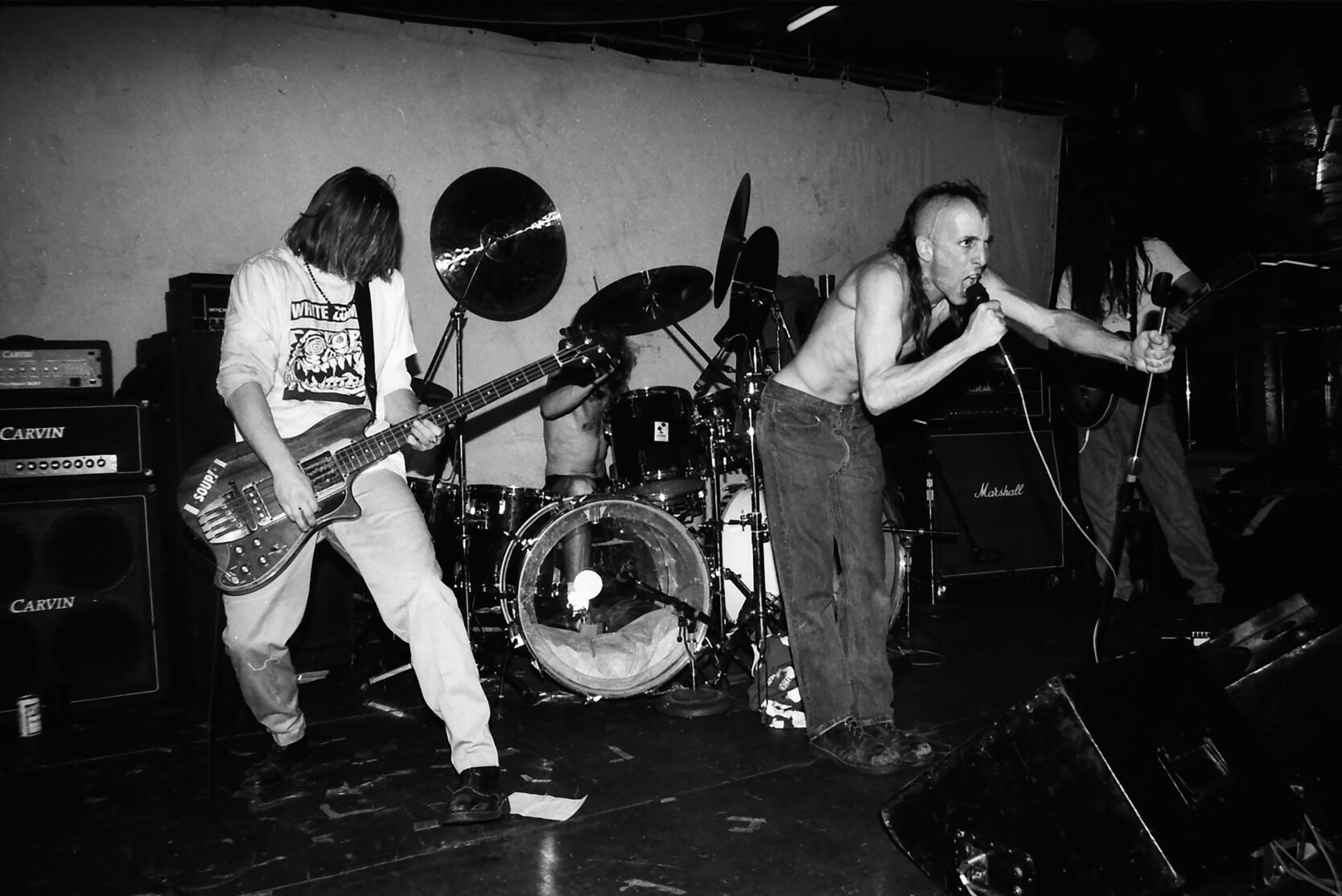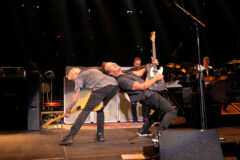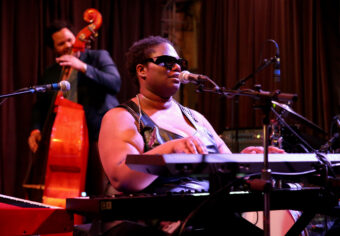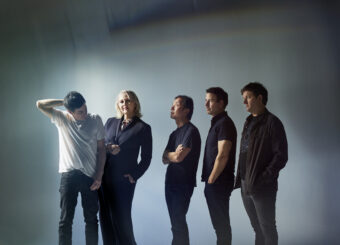1992 began with Nirvana dethroning Michael Jackson at the top of the Billboard 200, and a few months later MTV began airing Alternative Nation, enshrining alt-rock’s status as the sound of young America. SPIN’s album of the year was Pavement’s full-length debut, Slanted and Enchanted. Over the course of the year, R.E.M., Sonic Youth, Alice in Chains, Faith No More, Beastie Boys, and PJ Harvey released classic era-defining albums as well. Breakthrough albums by Stone Temple Pilots, Rage Against the Machine, Tori Amos, the Gin Blossoms, Soul Asylum, and Blind Melon would go on to sell millions.
On the margins, however, alternative and indie rock were splintering into a diverse range of styles, from lo-fi and ska-punk to space rock, dream pop and alt-metal. The underground was teeming with exciting new bands like Guided by Voices and Come. L7 and Therapy? were called up to the major labels, Television reunited, the B-52’s and They Might Be Giants followed up their biggest hits, and bands like Tool, No Doubt, and The Wallflowers released low-profile debuts that laid the groundwork for future hits.
Here are 30 unique, fascinating and sometimes great albums that turn 30 this year.
Gregg Alexander – Intoxifornication
Gregg Alexander kicked around the music industry for a decade before forming New Radicals and achieving pop immortality with 1998’s “You Get What You Give.” As a teenager, he released an album on A&M in 1989, and jumped to Epic in 1992 for another that completely missed the charts. Alexander’s recognizable voice and mischievous sense of humor are evident throughout Intoxifornication. The highlight is “The Truth,” where he quotes Foghat, dares them to sue and screams “I am a Jew! A Jew! And you’re my Hitler!”
Buy Intoxifornication on Amazon
Alice in Chains – Sap EP
By the end of 1992, Alice in Chains released their sludgy masterpiece Dirt. But they quietly kicked off the year with Sap, a collection of five acoustic songs that showed, for the first time, the mellower side of the band then known for “Man in the Box.” Chris Cornell and Mark Arm sing backup on “Right Turn,” jokingly credited to ‘Alice Mudgarden,’ while “Got Me Wrong” would eventually become a radio hit after appearing the Clerks soundtrack. In 1994, Alice in Chains would release their other, more famous acoustic EP, the chart-topping Jar of Flies.
The B-52’s – Good Stuff
After the B-52’s reinvented themselves with 1989 blockbuster, Cosmic Thing, they reunited with producers Nile Rodgers and Don Was for a similar follow-up. But with Cindy Wilson on hiatus from the group to focus on raising her children, the utopian good vibes of the band’s only album as a trio didn’t find much success on the charts. Wilson returned in 1994, and the group released one more album, 2007’s Funplex, before embarking on a farewell tour this year.
David Byrne – Uh-Oh
Although he’d released music as a solo artist in the 1980s while Talking Heads were together, Uh-Oh was the first David Byrne album after the group disbanded in 1991. Byrne’s biggest solo radio hit, “She’s Mad,” hit #3 on Billboard’s Modern Rock chart shortly after the final Talking Heads single, “Sax and Violins,” topped the chart. Uh-Oh was sold with a sticker on the cover denouncing the ”longbox” cardboard packaging that briefly became an industry standard in the early ‘90s.
Catherine Wheel – Ferment
1992 was a transitional time for British rock, as the shoegaze wave was starting to fade but Britpop had yet to redefine the landscape. The Great Yarmouth band Catherine Wheel’s debut album feels like a perfect artifact of that moment, with a hazier psychedelic sound than the harder riffs they’d be known for on subsequent albums. Ferment’s 7-minute epic “Black Metallic” was edited down for a single mix that became one of Catherine Wheel’s defining radio hits.
Come – 11:11
Thalia Zedek of Live Skull and Chris Brokaw of Codeine moved to Boston in the early ‘90s and formed Come, whose first release was an acclaimed 1991 installment in the Sub Pop Singles Club series. Come signed to Matador for the band’s first album. And the bluesy, cathartic sound of 11:11 won fans including Kurt Cobain, who invited Come to open several Nirvana shows in 1993. In 2013, Come’s original lineup reunited for a tour in honor of a deluxe reissue of 11:11.
Cracker – Cracker
Camper Van Beethoven was one of the most offbeat college radio staples of the ‘80s, mixing absurdist lyrics with unpredictable instrumentation influenced by ska and Eastern European and Middle Eastern folk music. After their breakup in 1990, frontman David Lowery’s new band with guitarist Johnny Hickman hit the ground running, with Cracker reaching #1 on the Modern Rock chart with their debut single “Teen Angst (What the World Needs Now).” Cracker’s meat-and-potatoes guitar rock was a little more straightforward than Camper Van Beethoven ever was. But Lowery’s sneering sense of humor comes through on songs like “Happy Birthday to Me” and “Can I Take My Gun to Heaven.”
Def Leppard – Adrenalize
Def Leppard emerged from a long hiatus and the amputation of drummer Rick Allen’s arm to release 1987’s Hysteria, one of the biggest hard rock albums of all time. Then the band suffered another tragedy with the 1991 death of guitarist Steve Clark. Mike Shipley, who had mixed Def Leppard’s ‘80s albums, took over production of Adrenalize when Mutt Lange was unavailable. The album topped the Billboard 200 for five weeks, but “Let’s Get Rocked” and its campy animated video never had the lasting impact of the Hysteria singles.
Guided by Voices – Propeller
Robert Pollard was a 35-year-old Ohio schoolteacher in 1992 when he decided that the 5th album by his obscure band Guided by Voices would be its farewell record. Instead, the proudly lo-fi Propeller became the tipping point to GBV’s ascent to indie rock stardom, and they soon began touring outside Ohio for the first time. Decades later, Propeller tracks like “Lethargy” and “Exit Flagger” are still staples of the band’s live repertoire.
INXS – Welcome to Wherever You Are
A few years removed from their ‘80s hitmaking peak, Welcome to Wherever You Are was the last INXS album to go platinum in America, thanks to the suave, breakbeat-driven single “Not Enough Time.” With all six members of the band sharing production credit for the first time, INXS adventurously reinvented its sound. But the vocal distortion Michael Hutchence favors on the album suggests that they were perhaps a little too influenced by U2’s reinvention a year earlier on Achtung Baby.
Buy Welcome to Wherever You Are on Amazon
The Jesus and Mary Chain – Honey’s Dead
The second year of the Lollapalooza tour was a tipping point for American alternative rock in 1992, with Red Hot Chili Peppers, Pearl Jam and Soundgarden all playing in support of their 1991 breakthroughs. But one of the most senior bands on the main stage, the Jesus and Mary Chain, were a lingering remnant of the more UK-dominated alternative landscape of the ‘80s. Still, the Scottish noise pop vets had a great year in ’92. “Far Gone and Out” and “Almost Gold” were hits on alternative radio, as was the Pixies’ cover of their “Head On.”
L7 – Bricks Are Heavy
Although Bikini Kill and Sleater-Kinney may have proven more influential, L.A. quartet L7 were arguably the most visible all-female rock band of the ‘90s. On Bricks Are Heavy, they made their big move from Sub Pop to a major label and scored the Butch Vig-produced hit “Pretend We’re Dead” that launched them to headliner status. But the most enduring anthem that Donita Sparks wrote for Bricks Are Heavy, a little ode to the value of holding grudges called “Shitlist,” was understandably never promoted to radio.
Buy Bricks Are Heavy on Amazon
Lush – Spooky
The aptly named London band, fronted by singer/guitarists Miki Berenyi and Emma Anderson, started out with the kind of dream pop sound associated with their label, 4AD Records. Lush’s second album, produced by Robin Guthrie of Cocteau Twins, topped the UK Indie charts bolstered by the single “For Love,” which broke through to American radio. But the band would move in a more up-tempo direction on 1996’s Lovelife before breaking up.
Material Issue – Destination Universe
Chicago power pop band Material Issue’s sophomore album was not as critically beloved as their 1991 breakthrough, International Pop Overthrow. But Destination Universe was another unfailingly catchy set of songs written by frontman Jim Ellison, including the top 10 modern rock hit “What Girls Want.” Sadly, Material Issue only released one more album before Ellison’s 1996 suicide.
Buy Destination Universe on Amazon
The Mighty Mighty Bosstones – More Noise and Other Disturbances
Ska punk would become ubiquitous by the end of the decade, but in the early ‘90s, the Mighty Mighty Bosstones were one of the few bands with a national profile leading the charge. Their second independent album, More Noise and Other Disturbances, featured their college radio breakout “Where’d You Go,” which they’d perform in the teen movie Clueless three years later, as well as live staples like “Dr. D” and “He’s Back.”
Buy More Noise and Other Disturbances on Amazon
No Doubt – No Doubt
Another leading light of the ska-punk explosion, No Doubt, made its debut in 1992. Gwen Stefani had originally been a backing singer in her brother Eric’s band, and gradually moved into the spotlight after original No Doubt frontman John Spence died by suicide in 1987. The only single from the band’s 1992 debut, “Trapped in a Box,” failed to chart, although it eventually appeared on the band’s multi-platinum compilation The Singles 1992-2003. But No Doubt’s more conventional ska tracks featured one early song co-written by Spence, “Paulina.”
Public Image Ltd – That What Is Not
When the Sex Pistols broke up, Johnny Rotten went back to being John Lydon and charted a very different course with his next band. The long-running Public Image Ltd have experimented with a variety of sounds over their first 7 albums, including dub and funk. But their only album of the ‘90s, That What Is Not, was the band’s most conventionally guitar-driven rock record. Album opener “Acid Drops” actually ends with a sample of Lydon chanting “no future” from one of his previous band’s classics, foreshadowing his next move. Shortly after That What Is Not, PiL went on hiatus, and the Sex Pistols embarked on a reunion tour in 1996.
Buy That What Is Not on Amazon
Jonathan Richman – I, Jonathan
On “Velvet Underground,” Jonathan Richman is still paying fond tribute to the band that inspired his own legendary proto-punk outfit, the Modern Lovers. But Richman’s largely acoustic solo work is softer and more whimsical, and I, Jonathan is one of his finest hours. Songs like the bittersweet “That Summer Feeling” and the college radio hit “I Was Dancing in the Lesbian Bar,” which he performed on Late Night with Conan O’Brien in 1993, lasted as well as any of his tracks.
Rollins Band – The End of Silence
After leaving Black Flag, Henry Rollins reconnected with one of his old friends from the D.C. punk scene, guitarist Chris Haskett, to form Rollins Band. Their breakthrough third album, The End of Silence, introduced an unusual fifth member of the band: Theo Van Rock. Theo was Rollins Band’s live soundman, but he appeared in band publicity photos and could be seen working a mixing board in their videos. 1992 was also the year Rollins released his first book of poetry, Black Coffee Blues, which was later recorded as a spoken word album with musical accompaniment by Haskett.
Buy The End of Silence on Amazon
Sloan – Smeared
The Halifax, Nova Scotia quartet Sloan was one of the dozens of bands making fuzzy guitar rock that Geffen Records signed while it was flush with Nirvana and Guns N’ Roses money in the early ‘90s. But after the band’s shoegaze-influenced debut, Sloan started to shed modern influences and become devoted to Beatlesque retro pop/rock, becoming a beloved institution in the Canadian alternative scene. And like the Beatles, all four members of Sloan wrote and sang lead, with bassist Chris Murphy’s dryly sarcastic “Underwhelmed” and drummer Andrew Scott’s “500 Up” becoming the album’s biggest singles.
Spiritualized – Lazer Guided Melodies
The Warwickshire psychedelic band Spaceman 3 split up in 1991, with Sonic Boom going solo and four other members of the band forming Spiritualized. Only frontman Jason Pierce would remain in Spiritualized beyond their debut album, Lazer Guided Melodies, but the album laid the blueprint for Spiritualized’s future sound. Songs like “Shine a Light” and “I Want You” took the space rock sound in a cinematic new direction, with druggy drones, lush string and brass arrangements, gospel influences, and entrancing Krautrock-inspired rhythms.
Buy Lazer Guided Melodies on Amazon
Izzy Stradlin & the Ju Ju Hounds – Izzy Stradlin & the Ju Ju Hounds
Izzy Stradlin was the Keith Richards of the classic Guns N’ Roses lineup, writing their most memorable riffs and occasionally contributing a raspy vocal. Stradlin left the band in 1991, shortly after completing their two Use Your Illusion albums, and returned to Indiana to form a new band. The debut from Izzy Stradlin & the Ju Ju Hounds had the bluesy, homespun charm of a Richards solo album, spinning off the rock radio hits “Shuffle It All” and “Somebody Knockin’.” Stradlin continued making solo records in recent decades, declining to be a part of Velvet Revolver or rejoin Guns N’ Roses.
The Sugarcubes – Stick Around for Joy
In the late ‘80s, the Sugarcubes broke out as the first Icelandic band to experience commercial success in America and the UK. And although frontwoman Björk would go on to greater fame as a solo artist, her only #1 on Billboard’s Modern Rock chart is still “Hit,” the funky lead single from the third and final Sugarcubes album.
Buy Stick Around for Joy on Amazon
Television – Television
Television flamed out more quickly than the other legendary CBGB bands, disbanding in 1978 after recording just two albums (the classic Marquee Moon and its disappointing follow-up, Adventure). 14 years later, the New York quartet reunited for a self-titled third album. And while it’s a little jarring to hear them in a different decade with a very different production aesthetic, their chemistry as a band was still remarkably intact. “1800 or So” and “Mars” are minor classics in the Television canon, and “Call Mr. Lee” got to #27 on Billboard’s Modern Rock chart, the band’s only charting single in the U.S. Television has continued to write new songs and play shows over the past 20 years, but a fourth album has yet to materialize, particularly since founding guitarist Richard Lloyd left the band in 2007.
Therapy? – Nurse
“Here I am, motherfuckers!” is what a voice shouts at the beginning of Irish power trio Therapy?’s major label debut, the second of two albums the band released in 1992. Therapy? were one of the most uniquely heavy UK alternative bands of the early ‘90s, sharing musical common ground with American alt-metal bands like Helmet and Prong. But the band found acclaim at home, with Nurse’s lead single, “Teethgrinder,” becoming their breakthrough hit on the UK charts.
They Might Be Giants – Apollo 18
The follow-up to John Linnell and John Flansburgh’s most beloved album, 1990’s Flood, was also the last They Might Be Giants album from their early run as a duo. Before expanding to a more conventional rock band with a rhythm section, Apollo 18 featured the hits “The Statue Got Me High” and “The Guitar.” But the album’s most memorable flourish may be “Fingertips,” a suite of short songs spread across 21 tracks near the end of Apollo 18, created to playfully take advantage of the then-novel shuffle function on CD players.
Tool – Opiate EP
When Zoo Entertainment signed Los Angeles quartet Tool, the label encouraged the band to record their heaviest songs first. So the band’s debut EP, which includes four studio tracks and two live tracks, is not just Tool’s most metal release, but perhaps their most musically direct. Songs like “Hush” and “Part of Me” are shorter with simpler 4/4 time signatures than the proggy songwriting that Tool would become known for on their full-length albums. 1992 was also the year that Tool frontman Maynard James Keenan guested on comedy metal band Green Jello’s top 40 novelty hit, “Three Little Pigs.”
Suzanne Vega – 99.9F
Suzanne Vega was hailed as the new face of folk music in the 1980s, but her fourth album was a sharp left turn into danceable grooves and playfully experimental textures with producer Mitchell Froom (Crowded House, Los Lobos). 99.9F was nothing like Vega’s early work — or even DNA’s popular dance remix of “Tom’s Diner” — but her intriguing new sound was a hit, with “Blood Makes Noise” becoming her first and only #1 on Billboard’s Modern Rock chart. After completing the album, Vega and Froom would marry and have a daughter together.
The Wallflowers – The Wallflowers
The curiosity factor was through the roof when one of Bob Dylan’s sons started gigging around the Sunset Strip in the early ‘90s. Jakob Dylan’s band signed with Virgin Records, and the Wallflowers’ self-titled debut is a sprawling 70-minute roots rock opus from a singer/songwriter with something to prove. The album earned positive reviews, but critics couldn’t help but notice traces of the elder Dylan in Jakob’s nasal vocals. The band made its television debut on Late Night with David Letterman, but the album and its singles never charted. Parting with Virgin after selling only 40,000 copies, the Wallflowers moved to Interscope and went multi-platinum with 1996’s Bringing Down the Horse.
XTC – Nonsuch
XTC’s tenth album for longtime label Virgin Records reached #1 on the Modern Rock charts with the single “The Ballad of Peter Pumpkinhead.” Nonsuch was perhaps the band’s most political album, with Andy Partridge’s barbed lyrics contrasting with the jangly mix of 12-string guitars and Hammond organs. But the band’s relationship with the label soon soured, and XTC went on strike until being released from their contract, resurfacing seven years later with a pair of independent albums.
If you purchase an independently reviewed product or service through a link on our website, SPIN may receive an affiliate commission.





